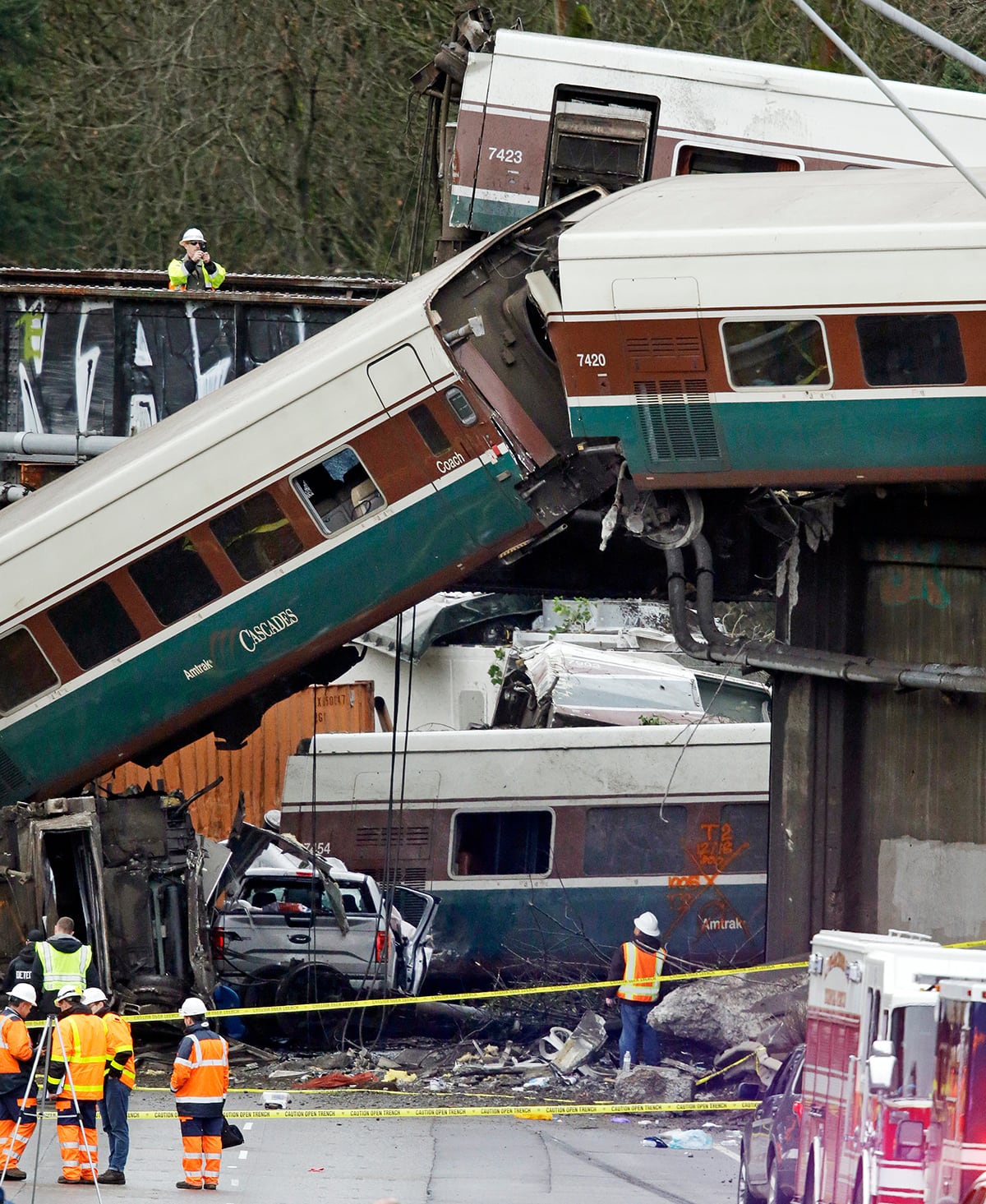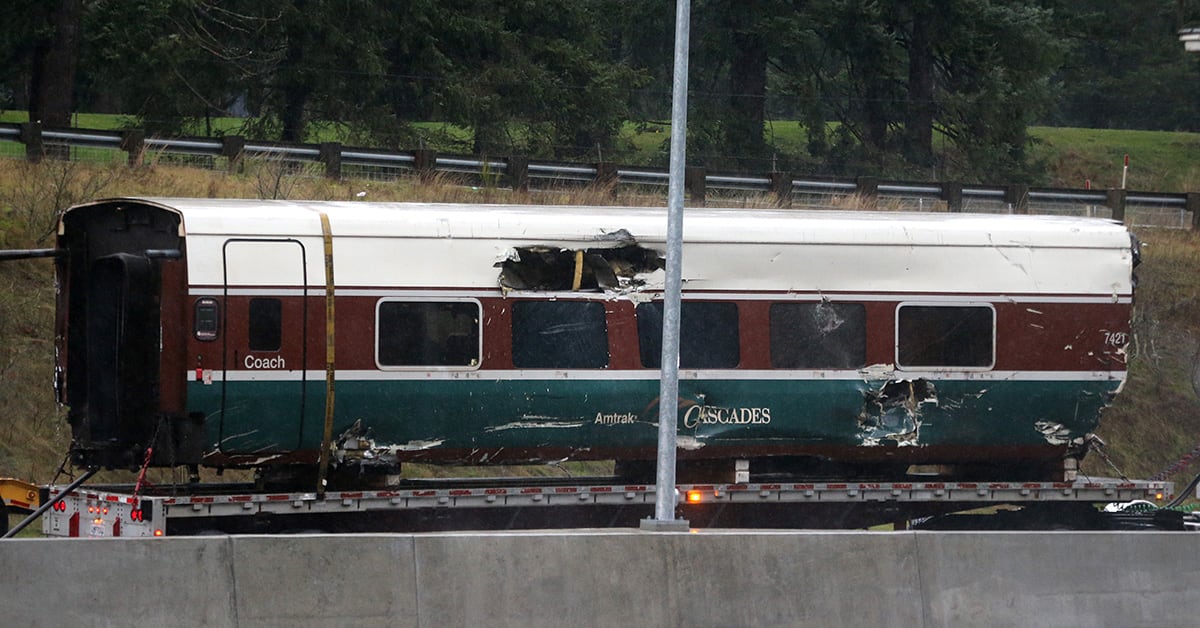TACOMA, Wash. — The scene that met Lt. Col. Christopher Sloan inside a derailed train car Monday morning was unlike anything he had seen in a war zone.
“The seats were everywhere, there was luggage everywhere. It was chaos,” Sloan said.
Injured victims were trapped under wreckage. Others, in a daze, were looking for lost cellphones and luggage.
Though the circumstances were new for Sloan, his military training wasn’t. And it kicked in.
“They needed help, and they needed to be cared for,” the Joint Base Lewis-McChord solider said Tuesday.
Sloan was just one of dozens of military personnel from JBLM who helped rescue and treat victims from the Amtrak Cascades train derailment that killed three people and injured more than 100 others near DuPont.
Three soldiers and several clinicians from Madigan Army Medical Center recounted their involvement with Monday’s derailment for local media.
Second Lt. Robert McCoy, an evacuation platoon leader in the 62nd Medical Brigade, had just completed physical fitness training at JBLM and was headed home Monday morning.
Driving south on Interstate 5 Monday, he saw the train with 14 cars and engines about to cross the span over the freeway. There was a loud noise and the bridge’s concrete abutments exploded.
“It fell off of the bridge and just kept coming and kept coming and kept coming,” McCoy said. Train cars fell on to the freeway and nearby slopes.
“I slammed on the brakes and pulled on to the shoulder,” he said.
McCoy found about eight people, who had been ejected from the rail cars, lying on the freeway.
Above the injured passengers a train car hung from the bridge, one end resting on another train car that sat flat on the freeway.
“My first concern was, if this falls it’s going to fall directly on these individuals,” McCoy said. He went into triage mode and began to move the victims out of harm’s way.
“Almost all of them were very dazed, really in a state of shock,” McCoy said.
Seconds earlier, Maj. Michael Livingston had been headed south to Lacey with his teen daughter.
Livingston, a nurse anesthetist, didn’t see the derailment but saw a cloud of smoke or steam rise, probably from a crushed automobile. He parked his car and ran to the scene.
He first checked on occupants of the cars and trucks that the train cars had hit. Livingston knocked on the locomotive’s door. A man inside indicated he was OK.
Livingston then turned his attention to the dangling train car.
“We all had that idea, that the car was going to fall and people were in it and our priority was to get those people out of it,” Livingston said.
Just then he saw a man dressed in U.S. Army physical fitness clothes begin climbing a semi-trailer that was smashed against the level train car.

“I saw Lt. McCoy scale up the back of the semi-trailer like Spider-Man so I thought I’ll get up the same way,” Livingston said.
Both men walked along the top of the level car to reach the end of the hanging car.
That’s where they found a woman struggling to get her mother out of the car. The older woman’s lower body seemed to be stuck in the remains of the car’s door.
“I reached under her and picked her up and put on the back on this rail car,” McCoy said.
While the men were assisting the women, Sloan, deputy commander for administration, was on his way to work at JBLM when he spotted the disaster.
A veteran of three deployments — two to Iraq — Sloan instantly knew he had happened upon a mass casualty event.
“I stopped my car. I backed it up, and I ran because there were people who needed help,” Sloan said.
First responders had yet to arrive.
“You could begin to see passengers exiting the rail car that was dangling off the bridge,” Sloan said.
Like McCoy and Livingston, Sloan climbed up the semi-trailer.
“That’s where I first met Maj. Livingston,” he said. And, seconds later, McCoy.
The younger woman told the men her husband and 8-month-old daughter were still trapped inside the car’s bathroom.
Livingston moved a mass of severed cables that had connected the two cars, and McCoy made his way into the car.
“He started banging the (bathroom) door so hard I thought he was going to break his kneecap,” Livingston said of McCoy. “But that door would not budge.”
The man said he and his baby were OK. They would wait for firefighters to free them.
As the men moved further up the dark and inclined car, Livingston moved aside dislodged panels and luggage racks.
“You saw shoes everywhere, backpacks, cellphones .” Livingston said. The car was also resting cockeyed.
“It was like a jungle in there,” Livingston said.
The soldiers used their cellphones as flashlights. They found dazed victims with broken limbs, head wounds and other injuries.
“We got people over the seats and out the door,” Sloan said. “Some people were bringing their luggage. Others were very animated to get out of this situation. There was no level surface anywhere in the car.”
Soon there were only two people left in the train car: a man with a broken arm and his wife who had a broken ankle.
“All we could see was her hip and a broken leg,” Sloan said. The woman was wedged under a seat.
The man wouldn’t leave his wife.
“They weren’t going to depart each other’s sides,” Sloan said.
The three soldiers lifted the seat off the woman.

“We pulled her out, inch by inch, until we could get her to sit up,” Sloan said. “And then she took a breath and said, ‘I’m going to be OK, I’m going to be OK.’ ”
Slowly they moved her down the steep car. She took breaks by resting on the soldiers’ legs.
By then firefighters had entered the car.
“First responders were on it, they were everywhere,” McCoy said.
The soldiers estimated they spent 90 minutes to two hours on the scene before firefighters sent them home.
“We took care of the people that needed to be taken care of,” Sloan said.
Lt. Col. Scott Grogan, director of family medical residency at Madigan, was having his daily huddle with his nursing staff, residents and faculty Monday morning.
“Right in the middle of that the overhead page came,” he said.
“Code Triage,” the announcement said.
“Is this real?” Grogan and others asked each other, accustomed to frequent drills. “The next call a minute later was ‘All available gurneys to the emergency department.’ ”
Madigan is a level two trauma center that treats both military and civilian patients. It sits seven miles from the scene of Monday’s derailment.
Col. Matthew Martin is chief of trauma and critical care at Madigan. On Monday morning, he was in an operating room, seconds away from opening a patient with his scalpel.
“The chief of anesthesia came in and said, ‘There’s been this train derailment and we’re expecting 50 to 70 patients,’ ” Martin said.
The patient, who was having elective surgery, was woken up, and the operating room was readied for a trauma patient.
The emergency room and intensive care units were also readied for a mass influx of patients, Martin said. Staff made plans on where the walking wounded would go.
Martin and others at Madigan, like Dr. Vance Sohn, are veterans of overseas deployments and mass casualty events.
“The way that we responded is just truly a reflection of the things that we’ve done in combat,” Sohn, director of general surgery, said.
Only 19 patients arrived at Madigan. Others were sent to hospitals from Olympia to Tacoma.
Most of the injuries from Monday’s disaster were from blunt force trauma. They included broken limbs, head wounds, abdominal injuries and cervical spine fractures, Martin said.
As of Tuesday afternoon, all of Madigan’s 12 patients who were admitted Monday were in serious or better condition.
“It was nothing short of a miracle,” nurse Emily Phillips said. “I was expecting way worse.”
Information from: The News Tribune, http://www.thenewstribune.com





